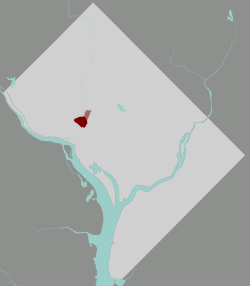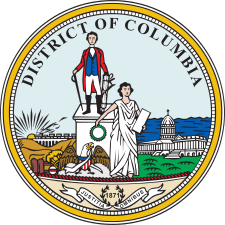Kalorama (Washington, D.C.)
The Kalorama area within the Northwest Quadrant of Washington, D.C. includes the residential neighborhoods of Kalorama Triangle and Sheridan-Kalorama. The area is accessible from the Dupont Circle and Woodley Park Metro stations, as well as various bus lines. Kalorama Triangle is bordered by Connecticut Avenue, Columbia Road, Calvert Street, and Rock Creek Park. Sheridan-Kalorama is adjacent, to the southwest, between Connecticut Avenue, Rock Creek Park, Massachusetts Avenue, and Florida Avenue.
Kalorama | |
|---|---|
Neighborhood of Washington, D.C. | |
Private residences and embassies located on Massachusetts Avenue in Sheridan-Kalorama | |
 Kalorama Triangle, (rose) Sheridan-Kalorama, (maroon), District of Columbia | |
| Coordinates: 38.9184°N 77.048°W | |
| Country | United States |
| District/City | Washington, D.C. |
| Ward | Wards 1 & 2 |
| Government | |
| • Councilmember | Brianne Nadeau |
History of two neighborhoods
The Kalorama area was primarily rural until the close of the 19th century, lying northwest of the original limits of Washington City from L'Enfant's original plan. In 1795, Gustavus Scott, a commissioner for the District of Columbia, purchased the property, which had been a portion of Anthony Holmead's "Widows Mite" holdings. He constructed a large, classically styled house at 23rd and S Streets, which he named Rock Hill. In 1803 Scott's wife, Margaret Scott, sold the property to William Augustine Washington.[1] In 1807, the poet, diplomat, and political philosopher Joel Barlow bought the property and renamed it "Kalorama," Greek for "fine view." Barlow lived in the home until shortly before his death in 1812. Barlow commissioned Capitol architect Benjamin Latrobe to enlarge the house and elevate its design. Kalorama (the residence) was destroyed by a fire during the American Civil War while it was used as a Union hospital. The residence was rebuilt and returned to a single-family home until 1887, when it was leveled by the District of Columbia government for the extension of S Street NW.
In the early 1880s, the Kalorama area, largely undeveloped because it lay beyond Boundary Street (now Florida Avenue) and thus outside the city limits, began to be subdivided for urban development. In 1893 Congress ordered L'Enfant's design of the city of Washington extended outward to include the rest of the District. Existing developments were exempted, which is why Kalorama is one of the few portions of D.C. that do not adhere to the city's street grid. Two high bridges over the deep gorge of Rock Creek became important to the development of both sides of Kalorama in this period, the Calvert Street bridge (since replaced by the Duke Ellington Bridge), built in 1891, and the Taft Bridge (on Connecticut Avenue), built in 1907.
Kalorama Triangle
2029 Connecticut Avenue | |
  | |
| Location | Roughly bounded by Connecticut Ave., Columbia Rd., and Calvert St. |
|---|---|
| NRHP reference No. | 87000627 |
| Added to NRHP | May 4, 1987 |
The Kalorama Triangle is a residential enclave of Adams Morgan in Northwest Washington, bounded by three major thoroughfares: Connecticut Avenue, Calvert Street, NW and Columbia Road. Kalorama Triangle is in the service area of Advisory Neighborhood Commission 1C, the Adams Morgan Advisory Neighborhood Commission, and is represented by the commissioners for 1C02.[2]
The neighborhood is served by mass transit, with the Woodley Park Metro station across the Taft or Duke Ellington Bridge, the 90/92/96/97/X3/L2 Metrobus lines and one of the DC Circulator lines stopping along its northern border (Calvert Street), the L1 Metrobus line (rush hour only) stopping along its western border (Connecticut Avenue), and the H1/42/43 Metrobus lines (H1 and 43 being rush hour only) stopping along its southeastern border (Columbia Road).
Sheridan-Kalorama / Kalorama Heights
Sheridan-Kalorama, also known as Kalorama Heights, is bounded to the north and west by Rock Creek Park; to the south and west by Massachusetts Avenue N.W.; and to the south and east by Florida Avenue and Connecticut Avenue N.W.
It is accessible by Metrorail by the Woodley Park and Dupont Circle stops on the Red Line. Kalorama Heights is assigned to Washington's Sheridan-Kalorama Advisory Neighborhood Commission (ANC 2D) and is designated as Single Member District 2D01 (the northeastern half) and 2D02 (the remainder).
The Sheridan-Kalorama Historic District is in southwestern Kalorama.[3][4][5][6]
Education
District of Columbia Public Schools operates public schools. Kalorama Heights is zoned to Marie Reed Elementary School in Adams Morgan.[7][8] Students in high school are assigned to Woodrow Wilson High School.[9]
Notable residents
Sheridan-Kalorama has been home to six former Presidents:
- Woodrow Wilson purchased a recently built house at 2340 S Street, NW, in 1921, and lived there until his death three years later. Following the death in 1961 of Wilson's widow, Edith, the Woodrow Wilson House was designated a National Historic Landmark in 1964 and became a museum dedicated to Wilson's memory.
- William Howard Taft lived in the large Colonial Revival house at 2215 Wyoming Avenue, from 1921 until his death in 1930. The house had been built by Alvan T. Fuller in 1908 on a design by local architect Appleton P. Clark, Jr., and is now the Syrian Embassy.
- Franklin D. Roosevelt and Eleanor Roosevelt lived at 2131 R Street from 1917 to 1920, while Assistant Secretary of the Navy. The house, originally built in 1899 with a 1901 addition, is now the residence of the ambassador of Mali.
- Warren Harding lived at 2314 Wyoming Avenue from 1917 to 1921, then as a U.S. Senator from Ohio. The house was built in 1915 in the Federal style on a design by architect George N. Ray, and is now the residence of the ambassador of Monaco.
- Herbert Hoover, when appointed Secretary of Commerce in 1921, purchased a house built by Thomas Gales in 1902 in the Colonial Revival style on a design by Appleton P. Clark, Jr. He lived there with his family until his inauguration in 1929 and after leaving the White House from 1933 to 1944. It has been the Embassy of Burma, then Myanmar since 1954.
- Barack Obama, Michelle Obama, and their two daughters have lived in Kalorama since Barack Obama's presidency ended on January 20, 2017.[10][11]
Jeff Bezos purchased a house in Kalorama in 2016. Formerly the Textile Museum, the property is currently undergoing renovation.[12]
Ivanka Trump and her husband, Jared Kushner, purchased a six-bedroom, 6,870 square feet (638 m2) home in Kalorama in December 2016.[13][14]
Other notable former Kalorama residents include Supreme Court justices Charles Evans Hughes, Louis Brandeis, Harlan F. Stone, Joseph McKenna and Sandra Day O'Connor, and Federal Reserve governors Adolph C. Miller and Frederic Adrian Delano. More recent ones include the late U.S. senator Ted Kennedy, former secretary of defense Donald Rumsfeld, former secretary of state Rex Tillerson,[15] historian Elizabeth Eisenstein, and former United States secretary of treasury Jack Lew.
The Sheridan-Kalorama neighborhood also includes a number of diplomatic residences, such as the residence of the French ambassador at 2221 Kalorama Road, as well as several embassies. On its southern side it includes much of Embassy Row on Massachusetts Avenue. The William Howard Taft Bridge, carrying Connecticut Avenue over Rock Creek Park, with its imposing concrete lions, is a notable feature. The Spanish Steps are another neighborhood landmark.
References
- Deed of Sale of property by Margaret Scott to William Augustine Washington, 27 Sep 1803.
- www.anc1c.org: Adams Morgan Advisory Neighborhood Commission
- National Park Service: Sheridan Kalorama Historic District . accessed 11.21.2013.
- District of Columbia Historic Preservation Office: Sheridan Kalorama Historic District Brochure
- District of Columbia Historic Preservation Office: Sheridan Kalorama Historic District Map
- Wikimedia Commons: Category: Sheridan-Kalorama Historic District — (images gallery).
- "Marie Reed Elementary School." District of Columbia Public Schools. Retrieved on October 3, 2016. "Neighborhood Cluster: Kalorama Heights, Adams Morgan, Lanier Heights"
- "Attendance Zones for Neighborhood Elementary & K–8 Schools S.Y. 2013–2014" (Archive). District of Columbia Public Schools. Retrieved on April 14, 2015.
- "Attendance Zones for Neighborhood High Schools S.Y. 2013–2014" (Archive). District of Columbia Public Schools. Retrieved on April 14, 2015.
- Hirschfeld Davis, Julie (May 25, 2016). "Obamas' Next Home: 9 Bedrooms in a Wealthy Washington Neighborhood". New York Times.
- Savransky, Rebecca (May 24, 2016). "Obamas pick DC neighborhood to move to in 2017". The Hill.
- Emily Heil and Kathy Orton (12 January 2017). "Jeff Bezos is the anonymous buyer of the biggest house in Washington". Washington Post. Retrieved 1 March 2019.
- Davis, Julie Hirshfield (4 January 2017). "Ivanka Trump's New Washington Home Once Belonged to a Putin Foe". New York Times. Retrieved 4 January 2017.
- Kashino, Marisa M. (Jan 3, 2017). "Ivanka Trump Will Move into a House in Kalorama". Washingtonian. Retrieved 4 January 2017.
- Benjamin Freed (February 22, 2017). "Rex Tillerson Buys $5.6 Million Kalorama Home". Washingtonian. Retrieved April 21, 2017.
External links
| Wikimedia Commons has media related to Sheridan-Kalorama. |
| Wikimedia Commons has media related to Kalorama Triangle, Washington, D.C.. |
- Kalorama Triangle Historic District
- Sheridan-Kalorama Historic District
- Sheridan-Kalorama ANC Website
- Kalorama Triangle Brochure
- A Washington Post article about the Kalorama Triangle
- Two articles about Sheridan-Kalorama from the Washington Post :
- A Kalorama "Pic Nic" With Wild Romantic Scenery – story about Kalorama from 1844 via Ghosts of DC
